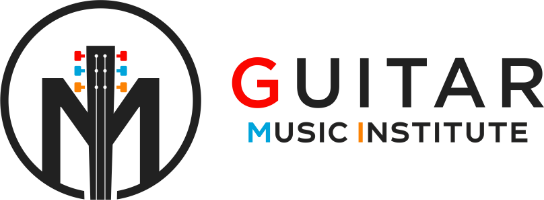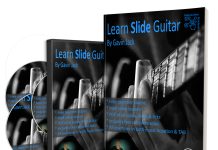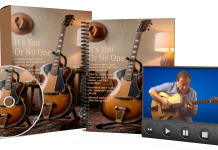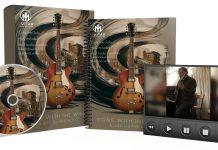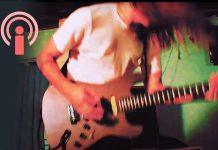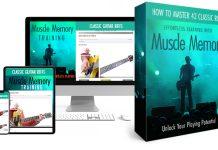This post may contain affiliate links. As an Amazon associate, Google associate as well as associate for other programs, Guitar & Music Institute may earn commissions from qualifying purchases.
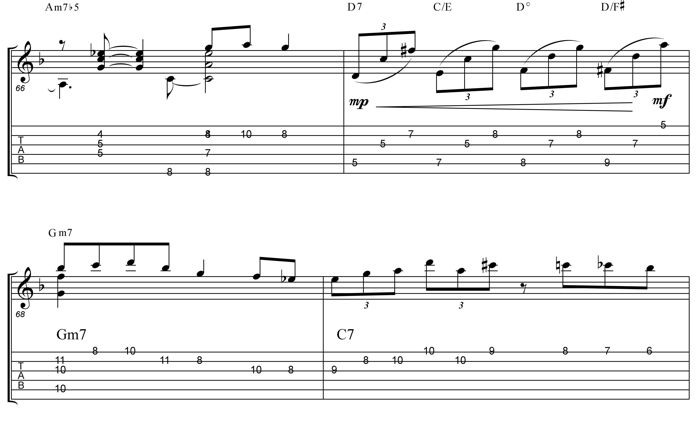
Are you ready to take your guitar playing skills to the next level? Learning how to read guitar tabs is the key to unlocking a world of musical possibilities. Guitar tablature, commonly known as “tab,” provides a visual representation of the guitar neck and strings, making it easier for beginners to learn songs quickly and easily. Unlike traditional sheet music, guitar tabs show you exactly where to place your fingers on the guitar to play the notes.
Key Takeaways:
- Learning how to read guitar tabs is essential for any aspiring guitarist.
- Guitar tabs provide a visual representation of the notes on the guitar neck and strings.
- Reading guitar tabs is a straightforward process of following the numbers on the lines.
- Guitar tabs often include symbols and techniques for more advanced playing.
- Listening to the song while using guitar tabs helps with timing and rhythm.
What are Guitar Tabs?
Guitar tabs are a visual representation of the notes in a song, specifically for the guitar. They provide a clear and easy-to-understand way of notating music for the guitar, allowing beginners to learn songs quickly and easily.
Guitar tabs consist of six horizontal lines, each representing a string on the guitar. The top line represents the high E string, while the bottom line represents the low E string. The numbers on the lines indicate which fret to play on each string. By following the numbers on the lines, you can easily find the right notes to play on the guitar.
| String | 0 Fret | 1st Fret | 2nd Fret |
|---|---|---|---|
| E | – | – | – |
| B | – | – | – |
| G | – | – | – |
| D | – | – | 2 |
| A | – | – | 2 |
| E | 0 | – | – |
In this example, the numbers indicate which fret to play on each string. The numbers “2” on the D and A strings indicate that you should press down the second fret on those strings, while the number “0” on the low E string indicates that you should play that string open (without pressing down any fret).
Guitar tabs are a valuable resource for guitarists of all levels. Whether you’re a beginner learning your favorite songs or an experienced guitarist looking to expand your repertoire, understanding how to read guitar tabs is an essential skill.
How to Read Guitar Tabs
Reading guitar tabs is a straightforward process. Guitar tabs are read from left to right, with each note represented by a number on a specific string and fret. The numbers indicate which fret to press down on the corresponding string.
For example, if you see the number 3 on the top line, it means you should press down on the third fret of the high E string. If you see the number 0, it means you should play the open string without pressing down any frets.
Chords are represented by multiple numbers stacked vertically on the same fret. Each number in the stack represents a different string. For example, if you see a stack of numbers 3-2-0 on the third fret, it means you should press down the third fret on the high E string, the second fret on the B string, and play the open G string.
When reading guitar tabs, it’s important to pay attention to the string and fret numbers to play the correct notes. Here’s a visual representation of the guitar tab notation:
| String | E | B | G | D | A | E |
|---|---|---|---|---|---|---|
| Number | 1 | 2 | 3 | 4 | 5 | 6 |
By referring to the table, you can easily identify which string corresponds to each line in the guitar tab. This helps you visualize the location of the notes on the guitar neck.
Now that you understand how to read guitar tabs, you can start decoding your favorite songs and play them on the guitar. Remember to practice regularly and familiarize yourself with the fretboard to improve your skills. Check out our latest free and paid guitar books and downloads at gmiguitarshop.

Techniques and Symbols in Guitar Tabs
Guitar tabs not only provide a visual representation of the notes on the guitar but also include symbols and techniques that enhance your playing. Mastering these guitar tab reading techniques and understanding the symbols used in tablature can greatly improve your playing and open up new possibilities for creativity.
Here are some commonly used symbols and techniques found in guitar tabs:
- Hammer-ons: Hammer-ons involve using your fretting hand to create smooth, connected sounds. To perform a hammer-on, you pick the first note and then use a finger on your fretting hand to quickly “hammer” onto a higher note on the same string without picking again.
- Pull-offs: Pull-offs are the opposite of hammer-ons. They involve using your fretting hand to create a smooth transition from a higher note to a lower note on the same string without picking again. To perform a pull-off, you pick the first note and then “pull off” your finger from a higher fret to reveal a lower note.
- Bends: Bends alter the pitch of a note by pushing or pulling the string. You can perform a bend by bending the string upwards or downwards to reach a higher or lower pitch, respectively.
- Slides: Slides involve moving from one note to another smoothly. To perform a slide, you pick the first note and then use your finger on the fretting hand to slide up or down the string to reach the next note without picking again. Slides can create a smooth and expressive sound.
- Vibrato: Vibrato adds expression to notes by shaking your finger on the string while holding a note. It creates a subtle pitch variation that adds richness and character to your playing.
- Tapping: Tapping is a technique that involves using your picking hand to tap the strings and produce notes. This technique allows you to play fast and intricate passages by tapping notes on the fretboard instead of picking or fretting.
By utilizing these techniques and understanding the symbols in guitar tabs, you can add depth and dynamics to your playing. Experiment with each technique and incorporate them into your favorite songs to enhance your musicality and take your guitar playing to the next level.
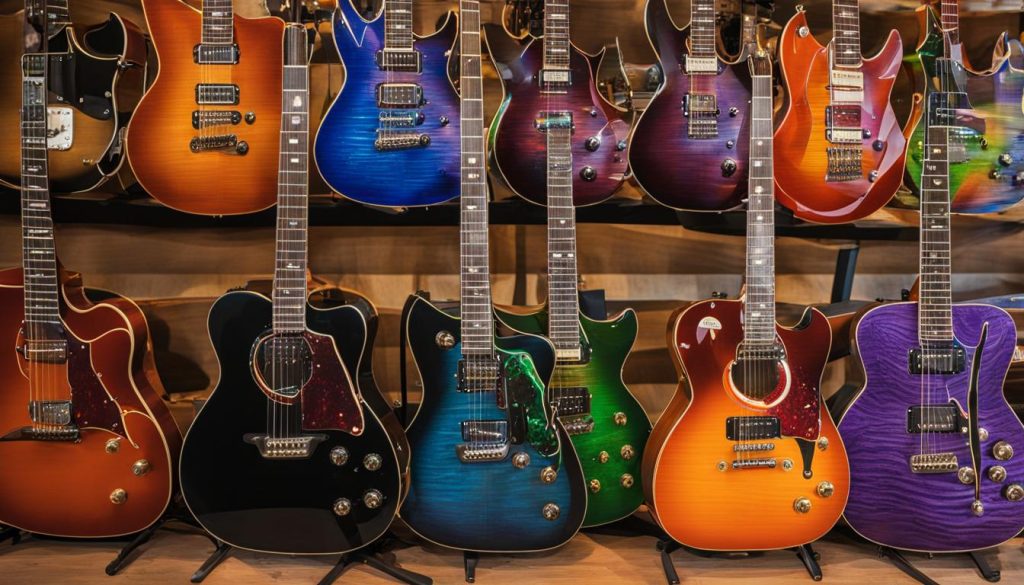
Check out our latest free and paid guitar books and downloads at https://gmiguitarshop.com/ for more resources to help you master guitar tablature and advance your guitar playing skills.
| Technique | Description |
|---|---|
| Hammer-ons | Using your fretting hand to create smooth, connected sounds by “hammering” onto a higher note on the same string |
| Pull-offs | Using your fretting hand to smoothly transition from a higher note to a lower note on the same string |
| Bends | Altering the pitch of a note by pushing or pulling the string |
| Slides | Moving from one note to another smoothly by sliding up or down the string |
| Vibrato | Adding expression to notes by shaking your finger on the string while holding a note |
| Tapping | Using your picking hand to tap the strings and produce notes |
Reading Guitar Tab Notation
When learning how to read guitar tabs, understanding the tab notation is crucial. Each line in a guitar tab represents a string on the guitar, and the numbers on the lines indicate which fret to play. This visual representation makes it easy to locate the notes and chords on the guitar neck.
Here are some key points to keep in mind when reading guitar tabs:
- Strings: The six horizontal lines in a guitar tab represent the strings on the guitar. The top line corresponds to the high E string, and the bottom line represents the low E string. The other lines go in ascending order, representing the B, G, D, A, and low E strings, respectively.
- Fret Numbers: The numbers on the lines indicate which fret to press down on the corresponding string. For example, if there’s a “3” on the high E string, you would press down the third fret on that string.
- Symbols and Techniques: Guitar tabs often include symbols and techniques to indicate how to play certain notes. These symbols may include bends, slides, hammer-ons, pull-offs, and more. Understanding the meaning of these symbols and techniques is crucial for accurately reproducing the music.
- Rhythm and Timing: Guitar tabs do not indicate note durations or rhythms. To follow along with the song, it’s helpful to listen to the music and use the tab as a guide for timing and rhythm.
By familiarizing yourself with the tab notation and practicing reading guitar tabs, you’ll be able to easily navigate through songs and play them with precision. Remember to focus on the string, fret numbers, and symbols to accurately replicate the music.
Playing Guitar with Tablature
Learning how to read guitar tabs opens up a world of possibilities for guitarists. With guitar tabs, you can learn to play your favorite songs and even compose your own music. Practice regularly and familiarize yourself with the fretboard to improve your guitar skills. As you become more comfortable with reading guitar tabs, you’ll be able to play more complex songs and even develop your own unique style. With dedication and practice, you can become a proficient guitarist and read guitar tabs like a pro.
Mastering Guitar Skills with Guitar Tabs
Reading guitar tabs is not only a useful skill but also a fun way to enhance your guitar playing abilities. With guitar tabs, you can quickly learn new songs without having to decipher complicated sheet music. Whether you’re a beginner or an experienced guitarist, guitar tabs provide a straightforward and efficient method to learn and play music.
Here are some tips to help you read guitar tabs like a pro:
- Start with simple songs: Begin by choosing songs with fewer chords and easier fingerings. This will help you build confidence and develop a solid foundation in reading guitar tabs.
- Focus on accuracy: Pay close attention to the string and fret numbers in the guitar tab. Ensure that you’re playing the correct notes and chords at the right positions on the fretboard.
- Practice regularly: Dedicate time each day to practice reading guitar tabs. Consistency is key to improving your skills and becoming proficient in playing songs using tablature.
- Explore different genres: Expand your repertoire by experimenting with various genres of music. This will expose you to different chord progressions and playing styles, further enhancing your ability to read guitar tabs.
- Use audio references: Listen to the songs you’re learning and try to follow along with the guitar tabs. This will help you develop your sense of timing, rhythm, and musicality.
Remember, reading guitar tabs is a tool to help you learn songs and express yourself through the guitar. Embrace the process, enjoy the journey, and keep pushing yourself to improve. With dedication and practice, you’ll soon be reading guitar tabs like a pro.
| Product | Description | Price |
|---|---|---|
| Beginner’s Guitar Tab Guide | A step-by-step guide for beginners to learn how to read guitar tabs and play popular songs. | $19.99 |
| Advanced Guitar Techniques | An advanced guide focused on mastering challenging guitar techniques and playing complex compositions. | $29.99 |
| Ultimate Songbook Collection | A comprehensive collection of guitar tabs for your favorite songs across various genres and eras. | $49.99 |
Start Your Guitar Tab Journey Today
Don’t wait any longer to dive into the world of guitar tabs. Begin your journey of mastering how to read guitar tabs and play your favorite songs with confidence. With dedication, practice, and the right resources, you can unleash your full potential as a guitarist and read guitar tabs like a pro.
Conclusion
Understanding how to read guitar tabs is a crucial skill for any guitarist. Guitar tablature provides a visual guide that allows you to learn songs quickly and easily, without the need for extensive knowledge of standard musical notation. By familiarizing yourself with the symbols and techniques commonly used in tablature, you can unlock a wide range of musical possibilities and express yourself creatively on the guitar.
Whether you’re a beginner just starting your musical journey or an experienced guitarist looking to expand your repertoire, mastering how to read guitar tabs is an essential step. It empowers you to play your favorite songs, compose your own music, and develop your unique style. With dedication and practice, you can become a proficient guitarist and navigate guitar tablature like a pro.
FAQ
What are guitar tabs?
Guitar tabs, also known as tablature, are a visual representation of the notes played on a guitar. They consist of six horizontal lines, each representing a string on the guitar, with numbers indicating which fret on a specific string to play.
How do I read guitar tabs?
Guitar tabs are read from left to right. Each note is represented by a number on a specific string and fret. The numbers indicate which fret to press down on the corresponding string. Chords are represented by multiple numbers stacked vertically on the same fret.
What symbols and techniques are used in guitar tabs?
Guitar tabs may include symbols and techniques such as hammer-ons, pull-offs, bends, slides, vibrato, and tapping. These indicate how to play specific notes or phrases on the guitar.
Do guitar tabs indicate note durations or rhythms?
No, guitar tabs typically do not indicate note durations or rhythms. It is helpful to listen to the song and follow along with the tab for timing and rhythm.
How can learning to read guitar tabs benefit me?
Learning to read guitar tabs allows you to quickly learn songs and play your favorite music. It also provides a basis for composing your own music and developing your guitar playing skills. Reading guitar tabs opens up a world of possibilities for guitarists of all levels.
How can I improve my guitar playing with tablature?
Practice regularly and familiarize yourself with the guitar’s fretboard. As you become more comfortable with reading guitar tabs, you’ll be able to play more complex songs and develop your own unique style. Dedication and practice are key to becoming a proficient guitarist.
Why is it important to learn how to read guitar tabs?
Learning how to read guitar tabs is essential for any guitarist, as it enables you to learn songs quickly and easily without needing to read traditional sheet music. It is a valuable skill that enhances your playing and allows you to express yourself creatively on the guitar.
Is it difficult to learn how to read guitar tabs?
Reading guitar tabs is a straightforward process that can be learned with practice and patience. With dedication and consistent effort, anyone can become proficient in reading guitar tabs.
Source Links
- https://www.schoolofrock.com/resources/guitar/reading-guitar-tabs-for-beginners
- https://www.pickupmusic.com/blog/the-ultimate-guide-to-reading-guitar-tab
- https://www.benaturalmusic.live/how-to-read-guitar-tabs/
This post may contain affiliate links. As an Amazon associate, Google associate as well as associate for other programs, Guitar & Music Institute may earn commissions from qualifying purchases.
